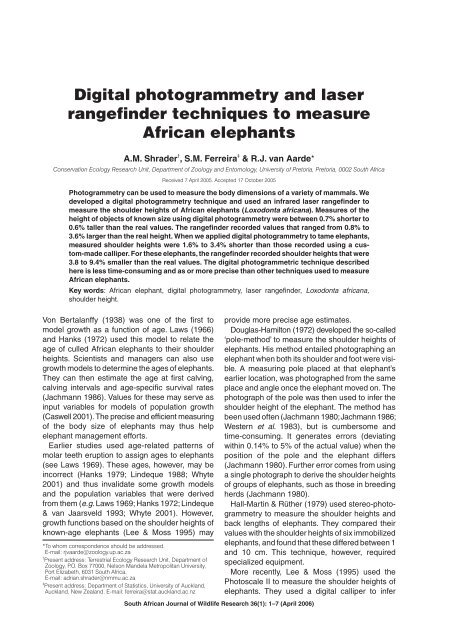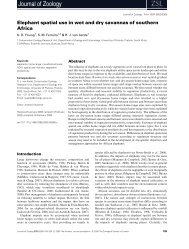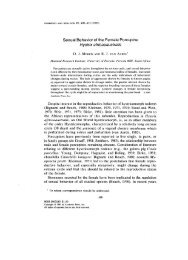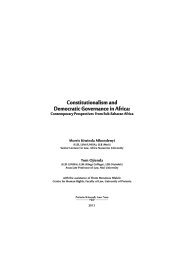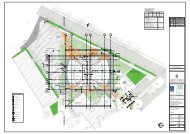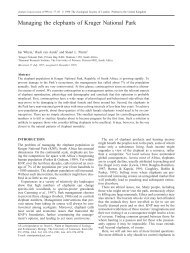Digital photogrammetry and laser rangefinder techniques to ... - CERU
Digital photogrammetry and laser rangefinder techniques to ... - CERU
Digital photogrammetry and laser rangefinder techniques to ... - CERU
Create successful ePaper yourself
Turn your PDF publications into a flip-book with our unique Google optimized e-Paper software.
<strong>Digital</strong> <strong>pho<strong>to</strong>grammetry</strong> <strong>and</strong> <strong>laser</strong><br />
<strong>rangefinder</strong> <strong>techniques</strong> <strong>to</strong> measure<br />
African elephants<br />
A.M. Shrader † , S.M. Ferreira ‡ & R.J. van Aarde*<br />
Conservation Ecology Research Unit, Department of Zoology <strong>and</strong> En<strong>to</strong>mology, University of Pre<strong>to</strong>ria, Pre<strong>to</strong>ria, 0002 South Africa<br />
Received 7 April 2005. Accepted 17 Oc<strong>to</strong>ber 2005<br />
Pho<strong>to</strong>grammetry can be used <strong>to</strong> measure the body dimensions of a variety of mammals. We<br />
developed a digital <strong>pho<strong>to</strong>grammetry</strong> technique <strong>and</strong> used an infrared <strong>laser</strong> <strong>rangefinder</strong> <strong>to</strong><br />
measure the shoulder heights of African elephants (Loxodonta africana). Measures of the<br />
height of objects of known size using digital <strong>pho<strong>to</strong>grammetry</strong> were between 0.7% shorter <strong>to</strong><br />
0.6% taller than the real values. The <strong>rangefinder</strong> recorded values that ranged from 0.8% <strong>to</strong><br />
3.6% larger than the real height. When we applied digital <strong>pho<strong>to</strong>grammetry</strong> <strong>to</strong> tame elephants,<br />
measured shoulder heights were 1.6% <strong>to</strong> 3.4% shorter than those recorded using a cus<strong>to</strong>m-made<br />
calliper. For these elephants, the <strong>rangefinder</strong> recorded shoulder heights that were<br />
3.8 <strong>to</strong> 9.4% smaller than the real values. The digital pho<strong>to</strong>grammetric technique described<br />
here is less time-consuming <strong>and</strong> as or more precise than other <strong>techniques</strong> used <strong>to</strong> measure<br />
African elephants.<br />
Key words: African elephant, digital <strong>pho<strong>to</strong>grammetry</strong>, <strong>laser</strong> <strong>rangefinder</strong>, Loxodonta africana,<br />
shoulder height.<br />
Von Bertalanffy (1938) was one of the first <strong>to</strong><br />
model growth as a function of age. Laws (1966)<br />
<strong>and</strong> Hanks (1972) used this model <strong>to</strong> relate the<br />
age of culled African elephants <strong>to</strong> their shoulder<br />
heights. Scientists <strong>and</strong> managers can also use<br />
growth models <strong>to</strong> determine the ages of elephants.<br />
They can then estimate the age at first calving,<br />
calving intervals <strong>and</strong> age-specific survival rates<br />
(Jachmann 1986). Values for these may serve as<br />
input variables for models of population growth<br />
(Caswell 2001). The precise <strong>and</strong> efficient measuring<br />
of the body size of elephants may thus help<br />
elephant management efforts.<br />
Earlier studies used age-related patterns of<br />
molar teeth eruption <strong>to</strong> assign ages <strong>to</strong> elephants<br />
(see Laws 1969). These ages, however, may be<br />
incorrect (Hanks 1979; Lindeque 1988; Whyte<br />
2001) <strong>and</strong> thus invalidate some growth models<br />
<strong>and</strong> the population variables that were derived<br />
from them (e.g. Laws 1969; Hanks 1972; Lindeque<br />
& van Jaarsveld 1993; Whyte 2001). However,<br />
growth functions based on the shoulder heights of<br />
known-age elephants (Lee & Moss 1995) may<br />
*To whom correspondence should be addressed.<br />
E-mail: rjvaarde@zoology.up.ac.za<br />
† Present address: Terrestrial Ecology Research Unit, Department of<br />
Zoology, P.O. Box 77000, Nelson M<strong>and</strong>ela Metropolitan University,<br />
Port Elizabeth, 6031 South Africa.<br />
E-mail: adrian.shrader@nmmu.ac.za<br />
‡ Present address: Department of Statistics, University of Auckl<strong>and</strong>,<br />
Auckl<strong>and</strong>, New Zeal<strong>and</strong>. E-mail: ferreira@stat.auckl<strong>and</strong>.ac.nz<br />
provide more precise age estimates.<br />
Douglas-Hamil<strong>to</strong>n (1972) developed the so-called<br />
‘pole-method’ <strong>to</strong> measure the shoulder heights of<br />
elephants. His method entailed pho<strong>to</strong>graphing an<br />
elephant when both its shoulder <strong>and</strong> foot were visible.<br />
A measuring pole placed at that elephant’s<br />
earlier location, was pho<strong>to</strong>graphed from the same<br />
place <strong>and</strong> angle once the elephant moved on. The<br />
pho<strong>to</strong>graph of the pole was then used <strong>to</strong> infer the<br />
shoulder height of the elephant. The method has<br />
been used often (Jachmann 1980;Jachmann 1986;<br />
Western et al. 1983), but is cumbersome <strong>and</strong><br />
time-consuming. It generates errors (deviating<br />
within 0.14% <strong>to</strong> 5% of the actual value) when the<br />
position of the pole <strong>and</strong> the elephant differs<br />
(Jachmann 1980). Further error comes from using<br />
a single pho<strong>to</strong>graph <strong>to</strong> derive the shoulder heights<br />
of groups of elephants, such as those in breeding<br />
herds (Jachmann 1980).<br />
Hall-Martin & Rüther (1979) used stereo-<strong>pho<strong>to</strong>grammetry</strong><br />
<strong>to</strong> measure the shoulder heights <strong>and</strong><br />
back lengths of elephants. They compared their<br />
values with the shoulder heights of six immobilized<br />
elephants, <strong>and</strong> found that these differed between 1<br />
<strong>and</strong> 10 cm. This technique, however, required<br />
specialized equipment.<br />
More recently, Lee & Moss (1995) used the<br />
Pho<strong>to</strong>scale II <strong>to</strong> measure the shoulder heights of<br />
elephants. They used a digital calliper <strong>to</strong> infer<br />
South African Journal of Wildlife Research 36(1): 1–7 (April 2006)
2 South African Journal of Wildlife Research Vol. 36, No. 1, April 2006<br />
shoulder heights from changes in the focal extension<br />
of a 300 mm lens fitted <strong>to</strong> a 35 mm film camera.<br />
Their method dealt with some of the limitations of<br />
the pole-method <strong>and</strong> stereo-<strong>pho<strong>to</strong>grammetry</strong>.<br />
However, the procedure <strong>to</strong>ok time, needed the<br />
development of film <strong>and</strong> led <strong>to</strong> errors of
Shrader et al.: <strong>Digital</strong> <strong>pho<strong>to</strong>grammetry</strong> <strong>and</strong> <strong>laser</strong> <strong>rangefinder</strong> <strong>techniques</strong> <strong>to</strong> measure elephants 3<br />
Fig. 2. Changes in (a) number of pixels comprising the length of the metre stick pho<strong>to</strong>graphed (i.e. pixels/m) <strong>and</strong><br />
(b) cm/pixel with distance for the three pixel densities (6.3 megapixels, 2.8 megapixels <strong>and</strong> 1.6 megapixels) <strong>and</strong><br />
four focal lengths (70 mm ◆, 100 mm ●, 135 mm ▲, <strong>and</strong> 200 mm ■).The number of pixels/m decreased exponentially<br />
with distance. Centimetres/pixel increased with distance <strong>and</strong> the rate of change in cm/pixel (i.e. slopes in the linear<br />
relationships) increased with decreasing pixel density <strong>and</strong> focal length.<br />
number of pixels in the length of the image of the<br />
metre stick decreased exponentially with distance<br />
(Fig. 2a). The number of cm/pixel increased<br />
linearly with decreases in pixel density <strong>and</strong> focal<br />
length (Fig. 2b; Table 1).<br />
To assess the accuracy <strong>and</strong> precision of our<br />
method we used the relationship for the highest<br />
pixel density <strong>and</strong> longest focal length. This gave<br />
the greatest number of pixels at the different<br />
distances (Fig. 2a). The 95% confidence interval
4 South African Journal of Wildlife Research Vol. 36, No. 1, April 2006<br />
Table 1. Functions describing the linear relationships between the number of cm/pixel (y ) <strong>and</strong> the distance <strong>to</strong> the<br />
subject in metres (x ) for the different pixel densities at the various focal lengths. Nearly 100% of the variation in<br />
cm/pixel was accounted for by variations in distance <strong>and</strong> focal length. Note that these focal lengths are not corrected<br />
for the camera’s 1.6 times magnification.<br />
Pixel density Focal length (mm) Function r 2<br />
6.3 megapixels 200 y = 0.0039x – 0.0020 1.0000<br />
135 y = 0.0056x – 0.0009 0.9996<br />
105 y = 0.0077x – 0.0074 0.9961<br />
70 y = 0.0105x – 0.0072 0.9998<br />
2.8 megapixels 200 y = 0.0059x – 0.0018 1.0000<br />
135 y = 0.0084x – 0.0020 0.9991<br />
105 y = 0.0115x – 0.0115 0.9995<br />
70 y = 0.0157x – 0.0119 0.9995<br />
1.6 megapixels 200 y = 0.0079x – 0.0051 0.9998<br />
135 y = 0.0115x – 0.0148 0.9994<br />
105 y = 0.0153x – 0.0116 0.9998<br />
70 y = 0.0210x – 0.0146 0.9997<br />
(CI) of the slope of the regression between<br />
actual height (h) <strong>and</strong> height estimated with the<br />
<strong>rangefinder</strong> (h i<br />
) were >1 (CI: 1.008–1.036, h i<br />
=<br />
1.022h–8.037, r 2 = 0.999, F 1,33<br />
= 22730, P < 0.001).<br />
The <strong>rangefinder</strong> thus overestimated the heights of<br />
the objects by 0.8 <strong>to</strong> 3.6%. In contrast, the 95%<br />
confidence interval of the slope for the digital<br />
<strong>pho<strong>to</strong>grammetry</strong> technique included 1 (CI: 0.993–<br />
1.006, h i<br />
= 0.9997h + 0.474, r 2 = 0.999, F 1,30<br />
=<br />
89880, P < 0.001). <strong>Digital</strong> <strong>pho<strong>to</strong>grammetry</strong> of the<br />
different objects yielded values from 0.7% smaller<br />
<strong>to</strong> 0.6% larger than the real measures. For five<br />
repeated measures of the same object, we noted a<br />
coefficient of variation of 1.45% <strong>and</strong> 0.2% when<br />
using the <strong>rangefinder</strong> <strong>and</strong> digital <strong>pho<strong>to</strong>grammetry</strong><br />
<strong>techniques</strong>, respectively.<br />
To assess the accuracies of the two methods for<br />
elephants, we measured five tame elephants at<br />
Letsatsing Game Reserve (Pilanesberg Elephant<br />
Back Safaris) <strong>and</strong> seven tame elephants at the<br />
Elephant Sanctuary near Brits, South Africa. The<br />
height of each elephant was measured with a large<br />
cus<strong>to</strong>m-built calliper that was placed next <strong>to</strong> the<br />
elephant with the cross arm resting on the<br />
elephant’s shoulder (Fig. 1a). Both <strong>techniques</strong><br />
underestimated the shoulder heights (h e<br />
) of the 12<br />
tame elephants.<strong>Digital</strong> <strong>pho<strong>to</strong>grammetry</strong>, however,<br />
was more accurate than the <strong>rangefinder</strong> underestimating<br />
heights by 1.6 <strong>to</strong> 3.4% (CI: 0.966–0.984,<br />
h e,i<br />
= 0.9752h e<br />
+ 7.051, r 2 = 0.996, F 1,180<br />
= 43480,<br />
P < 0.001). The <strong>rangefinder</strong> underestimated the<br />
shoulder heights by 3.8 <strong>to</strong> 9.4% (CI: 0.906–0.962,<br />
h e,i<br />
= 0.934h e<br />
+ 15.94, r 2 = 0.961, F 1,180<br />
= 4332, P <<br />
0.01). In addition, digital <strong>pho<strong>to</strong>grammetry</strong> was<br />
more precise than the <strong>rangefinder</strong> – the coefficient<br />
of variation for each elephant varied between 0.10<br />
<strong>and</strong> 2.06% using digital <strong>pho<strong>to</strong>grammetry</strong> <strong>and</strong> 0.54<br />
<strong>to</strong> 7.76% using the <strong>rangefinder</strong> (Table 2).<br />
Distance <strong>to</strong> the elephant did not influence the<br />
differences between the estimated <strong>and</strong> actual<br />
shoulder heights using either the <strong>rangefinder</strong><br />
technique (F 1,179<br />
= 0.35, P = 0.55; Fig. 3a) or digital<br />
<strong>pho<strong>to</strong>grammetry</strong> (F 1,179<br />
= 2.89, P = 0.10; Fig. 3b).<br />
However, the variances in <strong>rangefinder</strong> estimates<br />
were considerably larger as distance increased<br />
(F 1,35<br />
= 59.20, P < 0.01; Fig. 3c), but did not change<br />
when using digital <strong>pho<strong>to</strong>grammetry</strong> (F 1,35<br />
= 0.78,<br />
P = 0.38; Fig. 3c).<br />
Both of our <strong>techniques</strong> require less time <strong>to</strong><br />
measure elephants than the previous methods.<br />
Only the digital pho<strong>to</strong>grammetric method, however,<br />
yielded more accurate <strong>and</strong> precise measures<br />
than those recorded with other methods. The<br />
processing of film required when using the pole<br />
(Douglas-Hamil<strong>to</strong>n, 1972), stereo-pho<strong>to</strong>grammetric<br />
(Hall-Martin & Rüther 1979) or Pho<strong>to</strong>scale II (Lee<br />
& Moss 1995) methods, also delays the analysis of<br />
data. Our methods are free of this limitation.<br />
<strong>Digital</strong> <strong>pho<strong>to</strong>grammetry</strong> can capture data rapidly,<br />
while computer software allows for the measuring<br />
of a large number of individuals. <strong>Digital</strong> images of<br />
elephant groups may give measures of individuals<br />
providing the distance <strong>to</strong> each individual is known.<br />
In some cases, the sampling of large herds is best<br />
when elephants move past a fixed position where<br />
distances <strong>and</strong> images can be recorded with ease.<br />
In these cases, a single distance measurement is<br />
often enough when elephants move in single file
Shrader et al.: <strong>Digital</strong> <strong>pho<strong>to</strong>grammetry</strong> <strong>and</strong> <strong>laser</strong> <strong>rangefinder</strong> <strong>techniques</strong> <strong>to</strong> measure elephants 5<br />
Fig. 3. Estimated shoulder heights of tame elephants expressed as proportions of real height. Symbols 1 represent estimates that were greater. Proportions did<br />
not change with distance using (a) the <strong>rangefinder</strong> technique or (b) digital <strong>pho<strong>to</strong>grammetry</strong>. However, the st<strong>and</strong>ard<br />
error of proportions (c) increased with distance when using a <strong>rangefinder</strong> technique (◆), but not with digital <strong>pho<strong>to</strong>grammetry</strong><br />
().<br />
along game-paths <strong>to</strong> <strong>and</strong> from water.<br />
The performance of our digital pho<strong>to</strong>grammetric<br />
technique is similar <strong>to</strong> that of other non-invasive<br />
<strong>techniques</strong> (Douglas-Hamil<strong>to</strong>n 1972; Hall-Martin<br />
& Rüther 1979; Jachmann 1980; Western et al.<br />
1983; Lee & Moss 1995). For instance, Jachmann<br />
(1980) recorded additive errors of up <strong>to</strong> 6% within<br />
real values for the pole method.Lee & Moss (1995)<br />
reported
6 South African Journal of Wildlife Research Vol. 36, No. 1, April 2006<br />
Table 2.Comparison of actual heights with estimates of shoulder height (mean ± SE, n = 5 measurements) derived for<br />
12 elephants of different ages from various distances using (a) a <strong>laser</strong> <strong>rangefinder</strong> <strong>and</strong> (b) digital <strong>pho<strong>to</strong>grammetry</strong>.<br />
Values in brackets represent the mean distance from an individual elephant during the five repeat measures within the<br />
distance class.<br />
Elephant Sex Age Height<br />
(years) (cm)<br />
Distance classes<br />
~25 m ~30 m ~75 m ~115 m ~50 m ~65 m<br />
(a) Rangefinder<br />
Themba 8 2.2 137.00 137 ± 2.1 – 144 ± 1.5 – 139 ± 2.1 –<br />
(26.5 ± 0.2) (49.8 ± 0.1) (75.4 ± 0.1)<br />
Tumelo 9 5.5 155.00 158 ± 1.3 – 162 ± 2.9 – 165 ± 3.0 –<br />
(27.6 ± 0.1) (48.9 ± 0.1) (73.5 ± 0.5)<br />
Th<strong>and</strong>i 9 10.5 200.00 199 ± 0.8 – 207 ± 2.6 – 208 ± 3.5 –<br />
(24.9 ± 0.1) (49.3 ± 0.1) (75.7 ± 0.1)<br />
Jabu 9 12 201.00 201 ± 1.0 – 209 ± 2.1 – 198 ± 3.7 –<br />
(25.6 ± 0.1) (49.0 ± 0.1) (74.67 ± 0.1)<br />
Maroela 9 10.5 202.00 206 ± 1.4 – 214 ± 1.5 – 209 ± 3.5 –<br />
(26.0 ± 0.1) (49.6 ± 0.1) (75.0 ± 0.1)<br />
Khumba 9 11.5 211.00 210 ± 0.5 – 212 ± 1.9 – 214 ± 4.4 –<br />
(26.5 ± 0.4) (50.8 ± 0.1) (73.6 ± 0.1)<br />
Mosadi 9 12 211.00 215 ± 0.7 – 217 ± 2.8 – 211 ± 2.7 –<br />
(26.1 ± 0.3) (49.8 ± 0.1) (76.3 ± 0.1)<br />
Sappi 8 18 255.60 – 255 ± 2.0 – 257 ± 4.5 – 251 ± 3.8<br />
(29.2 ± 0.1) (62.6 ± 0.1) (115.7 ± 0.1)<br />
Sharu 8 19 257.00 – 260 ± 1.3 – 256 ± 3.4 – 257 ± 4.4<br />
(37.3 ± 0.1) (68.4 ± 0.1) (120.1 ± 0.1)<br />
Chikwenya 9 19 259.00 – 259 ± 2.1 – 253 ± 2.0 – 249 ± 6.4<br />
(30.8 ± 0.1) (66.6 ± 0.3) (119.1 ± 0.1)<br />
Mana 8 19.5 262.00 – 260 ± 2.9 – 262 ± 3.9 – 259 ± 9.0<br />
(32.4 ± 0.1) (66.1 ± 0.1) (119.1 ± 0.1)<br />
Michael 8 19.5 266.00 – 262 ± 1.2 – 257 ± 4.5 – 269 ± 6.0<br />
(30.3 ± 0.2) (62.4 ± 0.1) (115.2 ± 0.1)<br />
(b) <strong>Digital</strong> <strong>pho<strong>to</strong>grammetry</strong><br />
Elephant<br />
Sex Age Height<br />
(years) (cm)<br />
Distance classes<br />
∼25 m ~30 m ~75 m ∼115 m ∼50 m ∼65 m<br />
Themba 8 2.2 137 142 ± 0.9 – 142 ± 0.4 – 141 ± 0.2 –<br />
(26.5 ± 0.2) (49.8 ± 0.1) (75.4 ± 0.1)<br />
Tumelo 9 5.5 155 157 ± 0.2 – 159 ± 0.5 – 157 ± 0.7 –<br />
(27.6 ± 0.1) (48.9 ± 0.1) (73.5 ± 0.5)<br />
Th<strong>and</strong>i 9 10.5 200 198 ± 0.1 – 205 ± 0.8 – 203 ± 0.4 –<br />
(24.9 ± 0.1) (49.3 ± 0.1) (75.7 ± 0.1)<br />
Jabu 9 12 201 199 ± 1.2 – 202 ± 0.5 – 201 ± 0.5 –<br />
(25.6 ± 0.1) (49.0 ± 0.1) (74.7 ± 0.1)<br />
Maroela 9 10.5 202 205 ± 0.6 – 205 ± 0.2 – 203 ± 0.7 –<br />
(26.1 ± 0.1) (49.6 ± 0.1) (75.1 ± 0.1)<br />
Khumba 9 11.5 211 211 ± 0.7 – 215 ± 0.4 – 211 ± 1.9 –<br />
(26.5 ± 0.4) (50.8 ± 0.1) (73.6 ± 0.1)<br />
Mosadi 9 12 211 213 ± 0.6 – 217 ± 1.1 – 216 ± 0.4 –<br />
(26.1 ± 0.3) (49.8 ± 0.1) (76.3 ± 0.1)<br />
Sappi 8 18 255 – 254 ± 0.5 – 258 ± 0.5 – 258 ± 0.8<br />
(29.2 ± 0.1) (62.6 ± 0.1) (115.7 ± 0.1)<br />
Sharu 8 19 257 – 258 ± 0.4 – 258 ± 0.6 – 260 ± 0.4<br />
(37.3 ± 0.1) (68.4 ± 0.1) (120.1 ± 0.1)<br />
Chikwenya 9 19 259 – 254 ± 0.4 – 258 ± 0.9 – 257 ± 0.3<br />
(30.8 ± 0.1) (66.6 ± 0.3) (119.1 ± 0.1)<br />
Mana 8 19.5 262 – 263.5 ± 0.8 – 264 ± 0.2 – 266 ± 0.5<br />
(32.4 ± 0.1) (66.1 ± 0.1) (119.1 ± 0.1)<br />
Michael 8 19.5 266 – 267 ± 1.2 – 264 ± 0.3 – 264 ± 0.8<br />
(30.3 ± 0.2) (62.4 ± 0.1) (115.2 ± 0.1)
Shrader et al.: <strong>Digital</strong> <strong>pho<strong>to</strong>grammetry</strong> <strong>and</strong> <strong>laser</strong> <strong>rangefinder</strong> <strong>techniques</strong> <strong>to</strong> measure elephants 7<br />
To date, we have used our methods <strong>to</strong> measure<br />
the shoulder heights <strong>and</strong> back lengths of nearly<br />
10 000 elephants as part of surveys throughout<br />
southern Africa. One constraint of digital <strong>pho<strong>to</strong>grammetry</strong><br />
is that the camera model <strong>and</strong> specifications<br />
of the lenses used affect the measures made<br />
when using this method. <strong>Digital</strong> cameras change<br />
the magnification of images by a fac<strong>to</strong>r that varies<br />
between makes <strong>and</strong> models (i.e. Canon 1Ds = 1×,<br />
Nikon D1 <strong>and</strong> D100 = 1.5×, Canon 10D = 1.6×;<br />
<strong>Digital</strong> Pho<strong>to</strong>graphy Review 2004). The relationships<br />
between pixels/cm <strong>and</strong> distance that we<br />
found here will thus differ for other camera–lens<br />
combinations. These relationships should be<br />
calibrated for individual cameras using the<br />
approach described in the present study.<br />
ACKNOWLEDGEMENTS<br />
We would like <strong>to</strong> thank the Namibian Ministry of<br />
Environment <strong>and</strong> Tourism for permission <strong>to</strong> work in<br />
the E<strong>to</strong>sha National Park. Brett Mitchell <strong>and</strong> Craig<br />
Saunders kindly assisted by allowing us <strong>to</strong><br />
measure the tame elephants at Pilanesberg<br />
Elephant Back Safaris <strong>and</strong> The Elephant Sanctuary,<br />
respectively. All measurements of these animals<br />
were done in a humane <strong>and</strong> safe manner. The<br />
project was funded through grants <strong>to</strong> R.J.v.A. from<br />
the Peace Parks Foundation, the International<br />
Fund for Animal Welfare, the U.S. Fish & Wildlife<br />
Services <strong>and</strong> the University of Pre<strong>to</strong>ria. Brian<br />
Reilly <strong>and</strong> an anonymous reviewer provided<br />
comments that improved our manuscript.<br />
REFERENCES<br />
CASWELL, H.2001.Matrix population models:construction,<br />
analysis, <strong>and</strong> interpretation, 2nd edn. Sinauer<br />
Associates, Massachusetts.<br />
DIGITAL PHOTOGRAPHY REVIEW 2004. <strong>Digital</strong> Camera<br />
specifications. www.dpreview/reviews/specs.<br />
asp. Askey.Net Consulting.<br />
DOUGLAS-HAMILTON, I. 1972. On the ecology of the<br />
African elephant. Ph.D. thesis, University of Oxford,<br />
Oxford.<br />
HALL-MARTIN, A.J. & RÜTHER, H. 1979. Applications<br />
of stereo pho<strong>to</strong>grammetric <strong>techniques</strong> for measuring<br />
African elephants. Koedoe 22: 187–198.<br />
HANKS, J. 1972. Growth of the African elephant<br />
(Loxodonta africana). E. Afr. Wildl. J. 10: 251–272.<br />
HANKS, J. 1979. A struggle for survival. The elephant<br />
problem. C. Struik Publishers, Cape Town.<br />
JACHMANN, H. 1980. Population dynamics of the<br />
elephants in the Kasungu National Park, Malawi.<br />
Neth. J. Zool. 30: 622–634.<br />
JACHMANN, H.1986.Notes on the population dynamics<br />
of the Kasungu elephants. Afr. J. Ecol. 24: 215–226.<br />
LAWS, R.M. 1966. Age criteria for the African elephant,<br />
Loxodonta africana. E. Afr. Wildl. J. 4: 1–37.<br />
LAWS, R.M. 1969. The Tsavo research project.<br />
J. Reprod. Fert. (Suppl.) 6: 495–531.<br />
LEE, P.C. & MOSS, C.J. 1995. Statural growth in<br />
known-age African elephants (Loxodonta africana).<br />
J. Zool., Lond. 236: 29–41.<br />
LINDEQUE, M. 1988. Population dynamics of elephants<br />
in the E<strong>to</strong>sha National Park. Ph.D. thesis, University<br />
of Stellenbosch, Stellenbosch.<br />
LINDEQUE, M., & VAN JAARSVELD, A.S. 1993. Postnatal<br />
growth of elephants Loxodonta africana in<br />
E<strong>to</strong>sha National Park, Namibia. J. Zool., Lond. 229:<br />
319–330.<br />
ROBINSON, C. & RUDDOCK, L. 1984. Quantitative<br />
methods for surveyors.Construction Press, London.<br />
VON BERTALANFFY, L. (1938). A quantitative theory of<br />
organic growth. Human Biol. 10: 181–213.<br />
WESTERN, D., MOSS, C.J. & GEORGIADIS, N. 1983.<br />
Age estimation <strong>and</strong> population age structure of<br />
elephants from footprint dimensions. J. Wildl.<br />
Manage. 47: 1192–1197.<br />
WHYTE, I.J. 2001. Conservation management of the<br />
Kruger National Park elephant population. Ph.D.<br />
thesis, University of Pre<strong>to</strong>ria, Pre<strong>to</strong>ria.<br />
Corresponding edi<strong>to</strong>r: M.I Cherry


